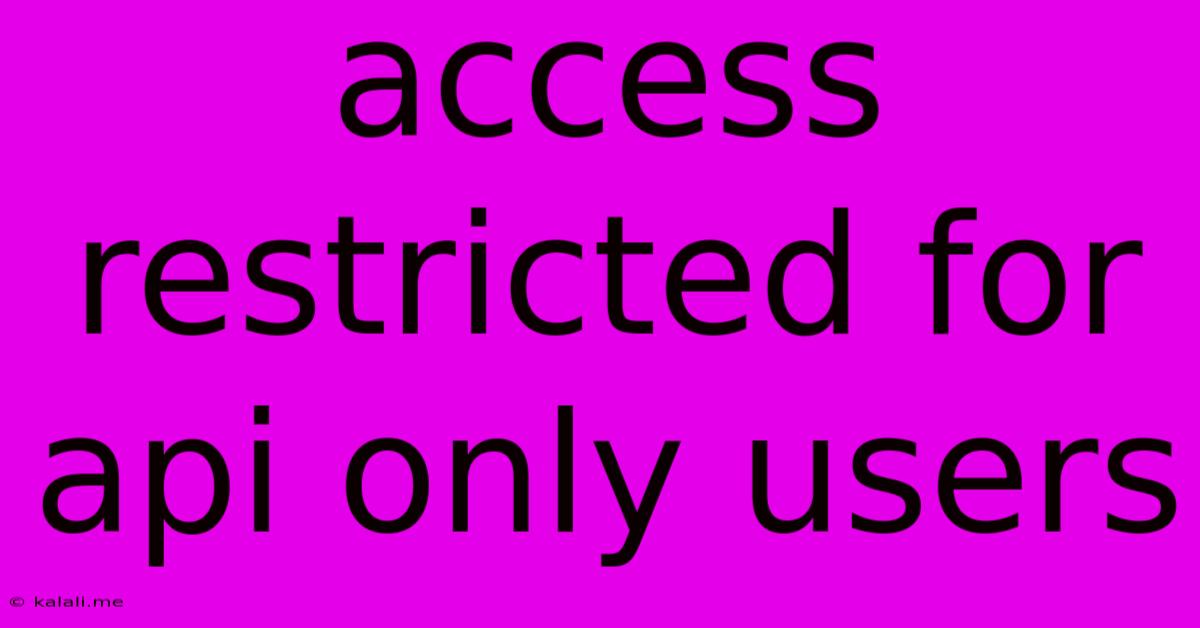Access Restricted For Api Only Users
Kalali
May 28, 2025 · 3 min read

Table of Contents
Access Restricted for API Only Users: A Comprehensive Guide
Meta Description: Learn how to effectively restrict API access to authorized users only, enhancing your application's security and preventing unauthorized data breaches. We'll explore various authentication and authorization methods to secure your APIs.
APIs (Application Programming Interfaces) are the backbone of many modern applications, enabling seamless data exchange between different systems. However, the open nature of APIs also presents a significant security risk. Unprotected APIs can be vulnerable to malicious attacks, leading to data breaches and system compromise. Therefore, restricting access to API-only users is paramount for maintaining the integrity and security of your application. This comprehensive guide explores various methods to effectively achieve this.
Understanding the Need for API Access Restriction
Before diving into the solutions, it's crucial to understand why restricting access is so important. Unsecured APIs can be exploited for various malicious purposes, including:
- Data breaches: Unauthorized access can lead to sensitive data exposure, impacting user privacy and potentially causing significant financial and reputational damage.
- Denial-of-service (DoS) attacks: Overwhelming an API with requests can render it unavailable to legitimate users.
- Manipulation of data: Unauthorized users could alter or delete critical data, disrupting application functionality.
- Account takeover: Compromised APIs can be used to gain unauthorized access to user accounts.
Implementing robust access control mechanisms is not just a best practice; it's a necessity for responsible API development.
Key Methods for Restricting API Access
Several methods can effectively restrict API access to authorized users only. The best approach often depends on the specific needs and complexity of your application.
1. API Keys: This is a common and relatively simple method. Each authorized user or application receives a unique API key, which they include in their requests to authenticate their identity. API keys should be carefully managed and rotated regularly to minimize the risk of compromise. Consider using API key rotation strategies to enforce regular updates.
2. OAuth 2.0: This widely adopted authorization framework provides a more robust and secure approach. OAuth 2.0 allows users to grant specific permissions to applications without sharing their credentials directly. This reduces the risk of credential theft and improves overall security. Common grant types include authorization code, client credentials, and implicit grant.
3. JSON Web Tokens (JWT): JWTs are self-contained tokens that contain user information and can be used for authentication and authorization. They are compact, easy to use, and can be easily verified by the API server. JWTs are often used in conjunction with OAuth 2.0 for enhanced security.
4. HTTPS: Always use HTTPS to encrypt communication between the client and the API server. This protects data in transit from eavesdropping and tampering. HTTPS is a fundamental security requirement for any API.
5. IP Address Whitelisting: This method restricts access to the API based on the IP addresses of authorized clients. While effective in some cases, it's not suitable for applications with multiple clients or those that use dynamic IP addresses.
6. Rate Limiting: This technique limits the number of requests a client can make within a specific time frame. It helps prevent DoS attacks and ensures fair usage of the API.
Implementing Effective Access Control
Regardless of the chosen method, implementing robust access control requires careful planning and execution. Consider these best practices:
- Thorough validation: Always validate API keys and tokens before processing requests.
- Input sanitization: Sanitize all input data to prevent injection attacks.
- Error handling: Implement appropriate error handling to prevent information leakage.
- Regular security audits: Conduct regular security audits to identify and address vulnerabilities.
- Documentation: Clearly document your API's security policies and access control mechanisms.
Conclusion
Restricting access to API-only users is crucial for ensuring the security and integrity of your applications. By implementing appropriate authentication and authorization mechanisms, coupled with best security practices, you can significantly reduce the risk of malicious attacks and protect your valuable data. Choosing the right method depends on the specific requirements of your application, but remember that security should always be a top priority.
Latest Posts
Latest Posts
-
To Obscure Or Block Out Light
May 30, 2025
-
Toilet Bowl Not Filling All The Way
May 30, 2025
-
How To Cite Poste Rpresentations That Werent Published
May 30, 2025
-
What Are Lighter Flints Made Of
May 30, 2025
-
Malaylam Vs Tamil Which Is Easier
May 30, 2025
Related Post
Thank you for visiting our website which covers about Access Restricted For Api Only Users . We hope the information provided has been useful to you. Feel free to contact us if you have any questions or need further assistance. See you next time and don't miss to bookmark.